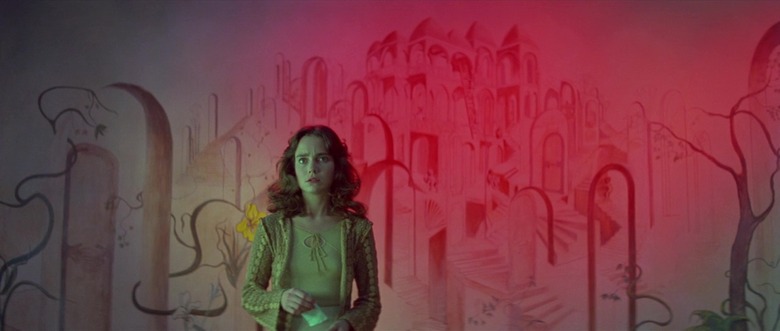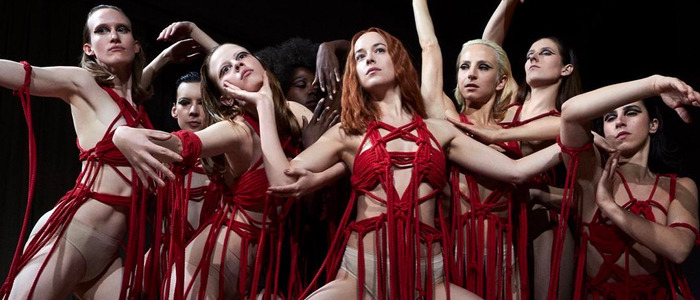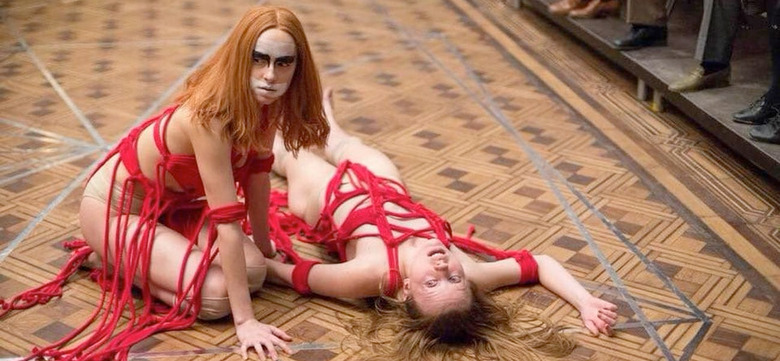A Horror Newbie Ends Her Horror Journey With The 1977 And 2018 'Suspiria'
(Welcome to The Final Girl, a regular feature from someone who has steered clear of horror and is ready to finally embrace the genre that goes bump in the night. Next and last on the list: Looking back at my horror journey through the 1977 and 2018 Suspiria.)
Well, here we are, old friend. You and me on the last page. I began this column about a year ago as a self-proclaimed horror newbie, not knowing what to expect of a genre that I had avoided for years. And now I emerge, bloody and screaming, with the realization that maybe I was a horror fan all along.
Suspecting the 1977 Suspiria
The first time I saw Dario Argento's Suspiria, I was prepared to watch it through my fingers. When I learned that I had to watch it as part of a college film class, surrounded by my less likely to be spooked peers, I steeled myself for the worst — that dreaded horror movie that each college film class would inevitably show. Instead, I found myself captivated by the vibrant, Technicolor nightmare that Argento splattered across the screen.
Suspiria was violent and gory to be sure, but it was also overwhelmingly poetic in Argento's command of color and visual language — the knives danced just as gracefully as the film's ballerinas and the splashes of blood more evoked a modern art painting than the slasher film I had expected. I was transfixed by the visual poetry of a film following an American ballerina (Jessica Harper) as she enrolls in a prestigious German ballet academy and slowly discovers that it is host to all sorts of strange occurrences and ghastly murders. There were deaths by vicious dog, shards of glass impaling beautiful, lean women, and disturbing imagery that would've made any horror fan squirm. And maybe, in another year, at another age, Suspiria would have opened the doors for me to appreciate the horror genre.
But let me give you some context: this was a film that we were watching for our "European Cinema" class (yes the title was as highfalutin as that). All the movies in the curriculum I expected to come with a vein of pretense, and Suspiria was almost violently refreshing from that. But still, because of the situation, I came to associate more with "arthouse" horror rather than general horror. Yes, all those painstaking debates over "elevated horror" was something that I fell victim to many years ago. I divided my expectations toward the genre as high vs. low horror, and figured I could make exceptions only for arthouse horror films and still deny horror in general as a genre.
But, without knowing it, I started to make more exceptions for other horror sub-genres — namely horror comedy, tracing back to my love for Buffy the Vampire Slayer. I figured, "It's not really horror if it's a satire," and gleefully watched films like Shaun of the Dead, The Cabin in the Woods, and even Scream. It's no wonder that it was a combination of satirical horror and arthouse (namely, Get Out and The Witch) that got me interested in diving into the genre just a few years ago. But jump to now, and I like to think that I've come out of this column with a fuller appreciation of the distinctive sub-genres within horror, and what makes them all so appealing.
Dancing With the Devilish 2018 Suspiria
Luca Guadagnino's previous film, Call Me By Your Name, had flooded my senses and seared itself into my memory until I was adrift in a fog of sun-dappled valleys and unspoken emotions. I eagerly anticipated his next project, but was surprised to learn that Guadagnino's next movie would be a remake of none other than Suspiria. The director of the dreamy coming-of-age gay romance was going to helm a remake of the visually explosive but narratively hollow horror film? I couldn't imagine it.
And Guadagnino defied all imagination when the first trailers for the 2018 Suspiria appeared. Gone were Argento's feverishly garish colors, and in its place, a bleak, unsettling portrait of 1977 Berlin with some demonic visions thrown in. It was a jarring difference, one that Guadagnino leans heavily into for the duration of Suspiria. Though Guadagnino's color palette was as subdued as could be, especially in comparison to Argentos' kaleidoscopic vision, the Italian filmmaker doesn't hesitate to assault our senses in a different way.
The languorous first half of the film is punctuated by quick, faster-than-the-eyes edits that serve to disconcert and disorient the viewer. Sometimes, often at random, the camera would jump into bizarre — but always beautifully cinematic — positions, such as one shot where a giant Dakota Johnson looms over Tilda Swinton in a scene that is practically baking with sexual tension. It all serves to make you highly uncomfortable and unsure if what you're watching is in any way rooted in reality, despite the grimy depictions of real-life German revolts taking place outside the prim doors of the ballet academy. Suspiria gives us Guadagnino's dreamlike mood again, but made into a nightmare.
There's no relaxing in Suspiria, even as the slow, nearly sluggish first act crawls toward a demented climax. It finds a way to circumvent Argento's attack of the visual senses and become an attack on everything else: your ears, your skin, your nerves. It's one long climax that never ends. But in the bonkers third act of Suspiria, I found myself cracking a deranged smile. This orgy of death and dancing, I found myself — dare I say — enjoying, more so even than the unnerving mood-setting of the first half of the film. It was this kind of off-the-rails sensation that you rarely find outside of a horror film, because inside these kinds of scenes are something reprehensible and weird that other genres don't dare to explore. But in horror, filmmakers are capable of unleashing their most base instincts, and that's what's so freeing.
This is not an epiphany that's new to anyone, and not even to me (I had a similar reaction to the insane third act of mother!) but it's something that I've come to appreciate as I close out this horror column. There really isn't any genre like horror.
Final Girl Thoughts
It felt like fate when I watched Frankenstein and Bride of Frankenstein and delighted in the familiar Gothic hallmarks that I had loved in my literature and movies. And then to watch Night of the Living Dead and see the potential for social commentary that the horror genre has often held. Even my mortal enemy, the slasher movie, proved to be eye-opening for me as I watched the birth of the first final girl (and the inspiration for my column's title), Laurie Strode.
Now, I can't say that after a year of writing this column on and off, that I'm a horror expert. There are still deep, dark pits into which I'm too scared to venture. And I'm still just as easily spooked and squeamish as before. But I've come to acknowledge that horror is more than a one-note genre comprising of only slasher baddies and jump scares. Though I guess, a few here and there don't hurt.



